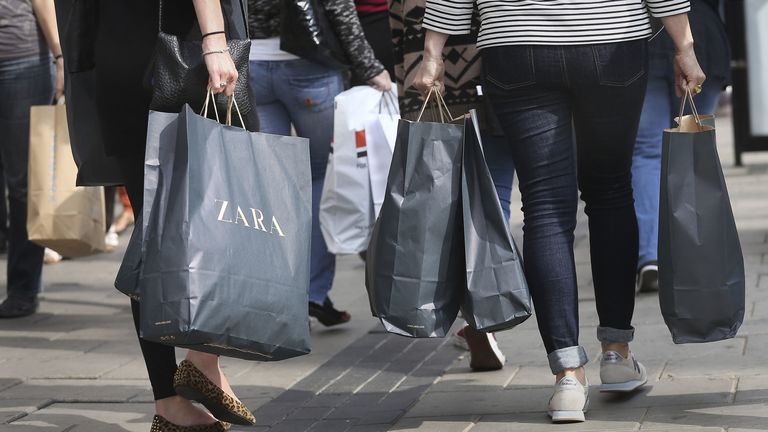Retail sales rose by 1.4% in November, lifted above their pre-pandemic level by an increase in sales at clothing stores and computer stores.
Volumes were 7.2% higher last month than February 2020 levels, according to the latest data from the Office for National Statistics (ONS), indicating a bounce back from the lows of the pandemic.
Non-food stores saw sales rise by 2.0%, driven by a 2.9% growth in clothing stores and 2.8% increase in other non-food stores such as computer stores, toy stores and jewellery stores.
Retailers pointed to Black Friday and Christmas shopping for the bump in sales, with clothing stores above pre-coronavirus levels for the first time since the onset of the pandemic.
Image: Black Friday sales boosted sales in NovemberFuel sales increased in November by 3.7% following two months of supply disruptions, although this was still some 1.9% below February 2020 levels.
Advertisement“Retail sales picked up in November, boosted by strong Black Friday and pre-Christmas trading,” said Heather Bovill, deputy director for surveys and economic indicators at the ONS.
“Clothing stores fared particularly well and have exceeded their pre-pandemic level for the first time. Computer, toy, and jewellery retailers also reported robust sales this month.”
More from BusinessBut with the jump in sales, fewer people were shopping online than at the height of the pandemic.
The proportion of retail sales online fell to 26.9% in November 2021, its lowest proportion since March 2020 and a continuation of a falling trend since its peak at 36.8% in February 2021.
“With more consumers choosing to visit the high street and retail parks, the proportion of online sales continued on a downward trend, to their lowest level since March 2020,” Ms Bovill added.
Image: Shoppers wearing face masks in Liverpool, as people have to wear face coverings in shops, shopping centres and on public transport in England to contain the spread of the Omicron Covid-19 variantBusinesses were urging the government this week not to further tighten restrictions in the build-up to Christmas.
Currys has revealed a pre-Christmas sales sales slowdown as supply chain strains hit the availability of some products and Omicron uncertainty threatens to further dampen demand.
Shares in the electricals-to-mobile phone retailer fell 9% on the update as the business became the latest to highlight the impact of latest fears over the new variant.
Wetherspoons has said it could slip to a half-year loss and, together with the CBI, has warned of the prospect of a “lockdown by stealth”.
Shoppers have to wear face coverings in shops, shopping centres and on public transport in England once again, in order to contain the spread of the Omicron COVID-19 variant.
“Strong retail sales in November were driven by Black Friday shoppers and consumers buying early for Christmas, determined to enjoy the celebrations this year”, Paul Martin, UK head of retail at KPMG, said of the ONS data.
“Consumers continue to shift away from household goods buying towards fashion, which has been the biggest winner of consumer spending over the last few months as we approach Christmas,” he said.
“Food sales continued to decline slightly, but are expected to grow as we head closer to the Christmas, with demand for premium labels likely to be high, as consumers shop for top quality items for family feasts over the festive period.”
“December could paint different picture for the sector, due to Covid restrictions and concern over rising infection numbers. Retailers will be hoping the roll out of the vaccine booster programme continues to bolster consumer confidence as we head into 2022, against a backdrop of rising interest rates and inflation, which could see the party come to an end and consumers pull back spending as they look to weather the storm and rising household costs.”
